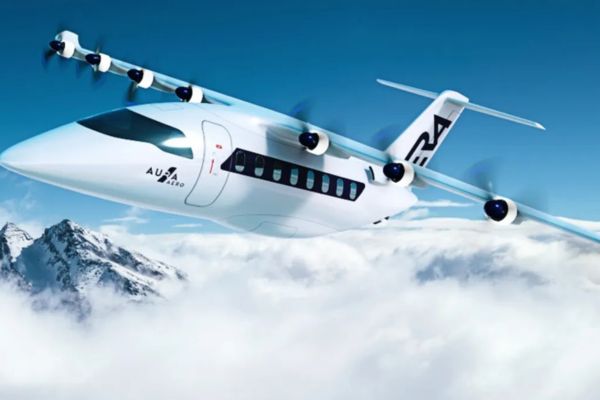The global electric aircraft market size is forecasted to reach around USD 71.19 billion by 2034 and is growing at a CAGR of 20.02% over the forecast period 2025 to 2034.
Key Highlights
- In 2024, North America accounted for the largest revenue share at 35.2%.
- Europe followed with the second-highest share, capturing 28.3% of the market.
- Within the market by system, the batteries segment led with a 32% revenue share in 2024.
- The aerostructure segment contributed a significant 27% to the market revenue by system in the same year.
Why Electric Aircraft?
Electric aircraft are being developed and promoted for several compelling reasons, particularly in the context of environmental, economic, and technological advancements. Here are the main motivations:
1. Environmental Benefits
- Zero Emissions (at point of use): Electric aircraft produce no carbon dioxide or nitrogen oxide emissions during flight, which can significantly reduce the aviation sector’s environmental footprint.
- Lower Noise Pollution: Electric motors are quieter than traditional jet or piston engines, reducing noise pollution near airports and in urban areas.
2. Cost Efficiency
- Lower Operating Costs: Electricity is generally cheaper than aviation fuel, and electric motors have fewer moving parts, leading to lower maintenance costs.
- Simpler Propulsion Systems: Electric powertrains are mechanically simpler than internal combustion engines, which can improve reliability and reduce servicing time.
3. Technological Innovation
- Advancements in Battery Technology: Improvements in energy density and weight of batteries are making electric flight more feasible.
- Distributed Propulsion: Electric motors can be placed in multiple locations on the aircraft (e.g., wing-integrated), offering new design possibilities and aerodynamic efficiency.
4. Urban Air Mobility (UAM) and eVTOL
- Electric Vertical Takeoff and Landing (eVTOL): Electric propulsion enables new types of aircraft that can take off and land vertically, ideal for urban air taxis and short-range transport.
- Short-Haul and Regional Travel: Electric aircraft are particularly suited for short to medium-range flights, potentially replacing many regional routes.
5. Regulatory and Public Pressure
- Government Incentives and Regulations: Policies are increasingly pushing for greener aviation technologies to meet climate targets.
- Public Demand for Sustainability: Growing environmental awareness among travelers is creating market pressure for greener alternatives.
6. Energy Security
- Less Dependence on Fossil Fuels: Electric aircraft can be powered by renewable energy sources, reducing reliance on oil and gas.
Challenges Still to Overcome
- Battery Energy Density: Current batteries store much less energy per kilogram than jet fuel, limiting range and payload.
- Infrastructure: Charging systems and grid upgrades are needed at airports.
- Certification and Safety: New technologies must meet strict aviation standards, which can slow development.
Electric Aircraft Market – Segmental Analysis
Type Analysis
Fixed-Wing Aircraft:
Fixed-wing electric aircraft refer to conventional airplane designs powered entirely by electric propulsion systems. Current trends in this segment center on improving battery efficiency and energy density to extend flight range and enhance operational performance. These advancements are making fixed-wing electric aircraft increasingly suitable for regional and short-haul commercial routes.
Rotary-Wing Aircraft:
Rotary-wing electric aircraft, including electric helicopters and eVTOL (electric Vertical Take-Off and Landing) vehicles, are designed for vertical lift. Key trends focus on the development of quiet and efficient electric propulsion systems, targeting applications in urban air mobility and cargo transport. Emphasis is placed on noise reduction, increased energy efficiency, and operational viability in densely populated environments.
Hybrid-Wing Aircraft:
Hybrid-wing electric aircraft blend the characteristics of both fixed-wing and rotary-wing configurations. Trends in this category involve the integration of hybrid-electric propulsion systems, which extend range capabilities while retaining flexibility for diverse mission profiles. These aircraft are being explored for regional transportation, emergency response, and aerial survey operations.
System Analysis
Batteries:
In 2024, the batteries segment accounted for the largest market share at 32%. As a core component of electric aircraft, battery technology is rapidly advancing in areas such as energy density, charge speed, and safety. Emerging trends include the development of solid-state batteries, which offer superior energy storage, reduced weight, and enhanced operational efficiency—key factors for expanding electric aircraft capabilities.
Electric Motors:
Holding a 22% market share in 2024, the electric motor segment is focused on innovation to improve performance. Trends highlight the development of more compact, lightweight motors with higher power density. These improvements aim to boost overall aircraft performance, reduce energy consumption, and increase the feasibility of electric propulsion for larger and more demanding aircraft.
Aerostructures:
The aerostructure segment secured the second-highest market share at 27% in 2024. Advancements in this area are driven by the adoption of lightweight materials, such as carbon fiber composites, and enhanced aerodynamic designs. Key trends include the use of additive manufacturing to produce complex, weight-optimized structures that improve flight efficiency, reduce drag, and support greater range and payload capacity.
Avionics
In 2024, the avionics segment accounted for 13% of the market share. Technological advancements in this segment are tailored to meet the unique demands of electric propulsion systems, such as optimized power management and intelligent control algorithms. Current trends include the development of smart avionics systems that enhance flight safety, operational efficiency, and overall reliability in electric aircraft.
Others
Representing 6% of the market share in 2024, this category includes essential components like charging infrastructure and thermal management systems. Trends focus on enabling fast, safe charging and maintaining optimal battery temperatures to ensure efficiency and safety across various operational conditions.
Technology Analysis
CTOL (Conventional Takeoff and Landing)
CTOL electric aircraft rely on standard runways for takeoff and landing. Market trends are centered on enhancing battery capacity and propulsion efficiency to improve range and payload, making them suitable for regional and short-haul operations. Regulatory efforts are underway to adapt existing aviation standards for electric aircraft integration.
STOL (Short Takeoff and Landing)
STOL electric aircraft are optimized for shorter or unpaved runways, offering operational flexibility in remote and urban environments. Key developments include improving propulsion systems for greater power-to-weight ratios and efficient short-distance performance, along with compliance with strict noise and emissions standards.
VTOL (Vertical Takeoff and Landing)
VTOL electric aircraft can take off and land vertically, removing the need for traditional runways. This segment is rapidly advancing through the development of eVTOL aircraft designed for urban air mobility and on-demand transport. Innovations include high-density battery systems, redundant propulsion units, and advanced flight control technologies to boost flight duration and safety.
End-User Analysis
Commercial Aviation
Electric aircraft are increasingly adopted in commercial aviation to lower emissions and operational costs, especially on short-haul routes. Trends include strategic collaborations between airlines and manufacturers to develop and test hybrid and fully electric regional aircraft, supporting sustainability goals.
Urban Air Mobility (UAM)
This segment focuses on intra-city transport using eVTOL aircraft, aimed at reducing traffic congestion and providing zero-emission alternatives. Key trends include infrastructure development for urban air corridors and charging networks, alongside the establishment of regulatory frameworks for air taxi operations.
Military and Defense
Electric aircraft in defense are primarily used for UAVs and surveillance missions. Trends include developing long-endurance UAVs and hybrid-electric systems for tactical use, offering advantages such as lower noise, reduced fuel dependency, and streamlined logistics.
Others
This category includes niche applications like electric gliders, recreational aircraft, and research platforms. Market growth is driven by innovations in lightweight composite materials and advanced battery systems, enabling extended flight time and enhanced performance across diverse aviation use cases.
Regional Analysis
North America – Market Leader
- 2024 Market Size: USD 4.04 billion
- 2034 Forecast: USD 25.06 billion
North America dominates the electric aircraft market due to robust R&D investments and supportive regulatory frameworks. Major trends include collaborations between aerospace corporations and startups, advancing electric propulsion systems and urban air mobility infrastructure. The region is also focusing on developing comprehensive charging and testing facilities.
Europe – Strong Push for Sustainability
- 2024 Market Size: USD 3.25 billion
- 2034 Forecast: USD 20.15 billion
Europe is at the forefront of sustainable aviation efforts, supported by government funding and environmental regulations. Key trends involve partnerships between aerospace firms and academic institutions to innovate in battery and hybrid-electric propulsion technologies. The region is a leader in eVTOL development for urban air transport.
Asia-Pacific – Rapid Market Expansion
- 2024 Market Size: USD 2.91 billion
- 2034 Forecast: USD 18.08 billion
Asia-Pacific is experiencing rapid growth in the electric aircraft sector, driven by rising urbanization and increasing air travel demand. The region is heavily investing in electric propulsion R&D, aiming for cost-effective solutions for short-haul and urban flights. Government incentives and startup activity are accelerating adoption.
LAMEA – Emerging Opportunities
LAMEA (Latin America, Middle East, and Africa) is exploring electric aviation for urban mobility and cargo logistics. While the region faces infrastructure and regulatory challenges, it benefits from geographic conditions suitable for electric aircraft trials. Ongoing partnerships between governments and international aerospace players aim to launch pilot projects and expand electric aviation capabilities.
Get Full Access of Report@ https://www.cervicornconsulting.com/buy-now/2330
















